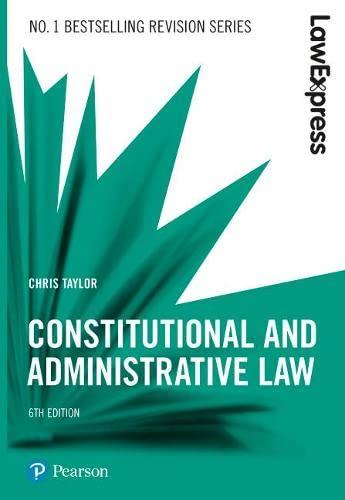Question
Ross v. Moffitt , 417 U.S. 600 _1974_; Case Brief The Ross case to look at has to do with whether there is a right
Ross v. Moffitt, 417 U.S. 600 _1974_; Case Brief
The Ross case to look at has to do with whether there is a right to counsel or constitutional protections of a state right to appointed counsel for discretionary appeals.
Heading:
a.Case name (to identify the parties)
b.Court name
c.Date of the decision
d.Page number where the case appears in the textbook
Statement of Facts
a. Identify the relationship/status of the parties (Note: Do not merely refer to the parties as the plaintiff/defendant or appellant/appellee; be sure to also include more descriptive generic terms to identify the relationship/status at issue, e.g., buyer/seller, employer/employee, landlord/tenant, etc.)
b. Identify legally relevant facts, that is, those facts that tend to prove or disprove an issue before the court. The relevant facts tell what happened before the parties entered the judicial system.
c. Identify procedurally significant facts. You should set out (1) the cause of action (C/A) (the law the plaintiff claimed was broken), (2) relief the plaintiff requested, (3) defenses, if any, the defendant raised.
Procedural History (PH)
This is the disposition of the case in the lower court(s) that explains how the case got to the court whose opinion you are reading. Include the following:
a. The decision(s) of the lower court(s).
NOTE: If the case was decided by a trial court and reviewed by an intermediate appellate court before reaching the court whose decision you are now reading, be sure to note what each court decided.
b. The damages awarded, if relevant.
c. Who appealed and why.
Issues:
a. Substantive issue: A substantive statement of the issue consists of two parts -
i. the point of law in dispute
ii. the key facts of the case relating to that point of law in dispute (legally relevant facts)
You must include the key facts from the case so that the issue is specific to that case. Typically, the disputed issue involves how the court applied some element of the pertinent rule to the facts of the specific case. Resolving the issue will determine the court's disposition of the case.
b. Procedural issue: What is the appealing party claiming the lower court did wrong (e.g., ruling on evidence, jury instructions, granting of summary judgment, etc.)?
Judgment: This is the court's final decision as to the rights of the parties, the court's response to a party's request for relief. Generally, the appellate court will either affirm, reverse, or reverse with instructions. The judgment is usually found at the end of the opinion.
Holding: This is a statement of law that is the court's answer to the issue. If you have written the issue statement(s) correctly, the holding is often the positive or negative statement of the issue statement.
Rule of Law or Legal Principle Applied: This is the rule of law that the court applies to determine the substantive rights of the parties. The rule of law could derive from a statute, case rule, regulation, or may be a synthesis of prior holdings in similar cases (common law). The rule or legal principle may be expressly stated in the opinion or it may be implied.
Reasoning: This is the court's analysis of the issues and the heart of the case brief. Reasoning is the way in which the court applied the rules/legal principles to the particular facts in the case to reach its decision. This includes syllogistic application of rules as well as policy arguments the court used to justify its holding (why the decision was socially desirable).
Concurring/Dissenting Opinions: A judge who hears a case may not agree with the majority's decision and will have a separate dissenting opinion. Another judge may agree with the decision but not with the majority's reasoning and will have a separate concurring opinion. Note the concurring/dissenting judge(s)' reasons for refusing to join in the majority opinion.
Additional Comments/Personal Impressions: What are your reactions to and critique of the opinion? Anything you like? Dislike? How does this case fall in line with the other cases you have read? Do not accept the court's opinion blindly. Assess the reasoning in each case. Is it sound? Is it contradictory? What are the political, economic or social impacts of this decision?
Step by Step Solution
There are 3 Steps involved in it
Step: 1

Get Instant Access to Expert-Tailored Solutions
See step-by-step solutions with expert insights and AI powered tools for academic success
Step: 2

Step: 3

Ace Your Homework with AI
Get the answers you need in no time with our AI-driven, step-by-step assistance
Get Started


